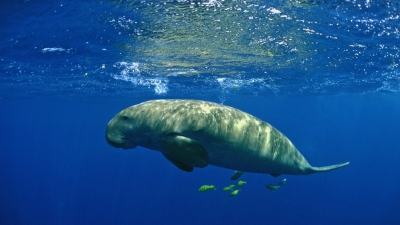
A gentle giant, the dugong is functionally extinct in China. Dugong, a gentle marine mammal related to the manatees that lived in China’s southern waters for hundreds of years, has been declared functionally extinct – so few in number that it cannot recover – in the country.
Weighing almost half a tonne, the ocean’s most gentle giant is the only vegetarian marine mammal. Its diet consists mostly of seagrass. Despite having an appearance similar to the manatee, it is different due to its dolphin fluke-like tail and gentle disposition. Some people believe that it inspired ancient tales of mermaids and sirens.
Commonly known as “sea cows”, dugongs are usually found in the coastal waters from East Africa to Vanuatu and even Japan. They are found in 37 more tropical regions in the world, especially in the shallow coastal waters of the Indian and western Pacific Oceans.
The creature is listed as vulnerable in the International Union for Conservation of Nature Red List.
According to research by the Zoological Society of London and the Chinese Academy of Sciences, fishing, ship strikes, and human-caused habitat loss have resulted in the rapid decrease in the number of dugongs since the 1970s.
The mammal had been sought by hunters in the 20th Century for its meat, skin, and bones. With a significant decline in the population, the mammal has been declared a Grade 1 National Key Protected Animal since 1988 by the Chinese State Council. There has been no verified dugong sightings by scientists since 2000.
The research was done by a team of international scientists who conducted interviews in 66 fishing communities across four Chinese provinces along the coastal region of the South China Sea.
Fishing, ship strikes, and human-caused habitat loss have resulted in the rapid decrease in the number of dugongs since the 1970s.
Picture Credit : Google




